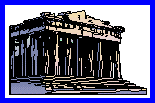

Many years ago, King Aegus sent his guest Androgeus on a dangerous mission. The boy was sent to fight a bull. The bull killed the boy. Androgeus' father, King Minos, threatened to invade Athens and take revenge unless every nine years Athens sent him seven young boys and seven young girls. Their fate was gruesome. They were fed to the Minotaur.
The Minotaur had the body and head of a bull and the face of a man. At its birth it was foretold that the Minotaur would never be killed by club, knife, spear or sword.
To protect the people from the monster, King Minos ordered Daedalus, the world's great builder and architect, to construct a complex labyrinth to restrain the freak. Inspired by the winding river Maeander which seems to have no beginning or end as it flows back upon itself in its course to the sea, Daedalus made a labyrinth with a thousand doors and so many twisting paths that once inside no one could find their way out.
Each nine years, 14 boys and girls from Athens were lead to the labyrinth and given to the beast. The paths of the labyrinth were littered with the whitened bones of past visitors.
Theseus led the 13 frightened children to the entrance of the labyrinth. He concealed a spool of yellow yarn in his golden hair. Upon entering the labyrinth, he tied the yarn to an olive tree. As he and the children explored the many passageways of the maze, the yarn unraveled behind them marking their path in a bright yellow line.
When they found the Minotaur, Theseus remembered that it could not be killed with club or knife or sword or spear. So he attacked the Minotaur with his fists and killed it.
Upon his return to Athens he was made King. But Theseus did not accept. He declined to rule over others and organized the first state in which all persons voted and governed themselves. Athens was the first democracy.

Web Designs supplied by

Graphic Design supplied by
